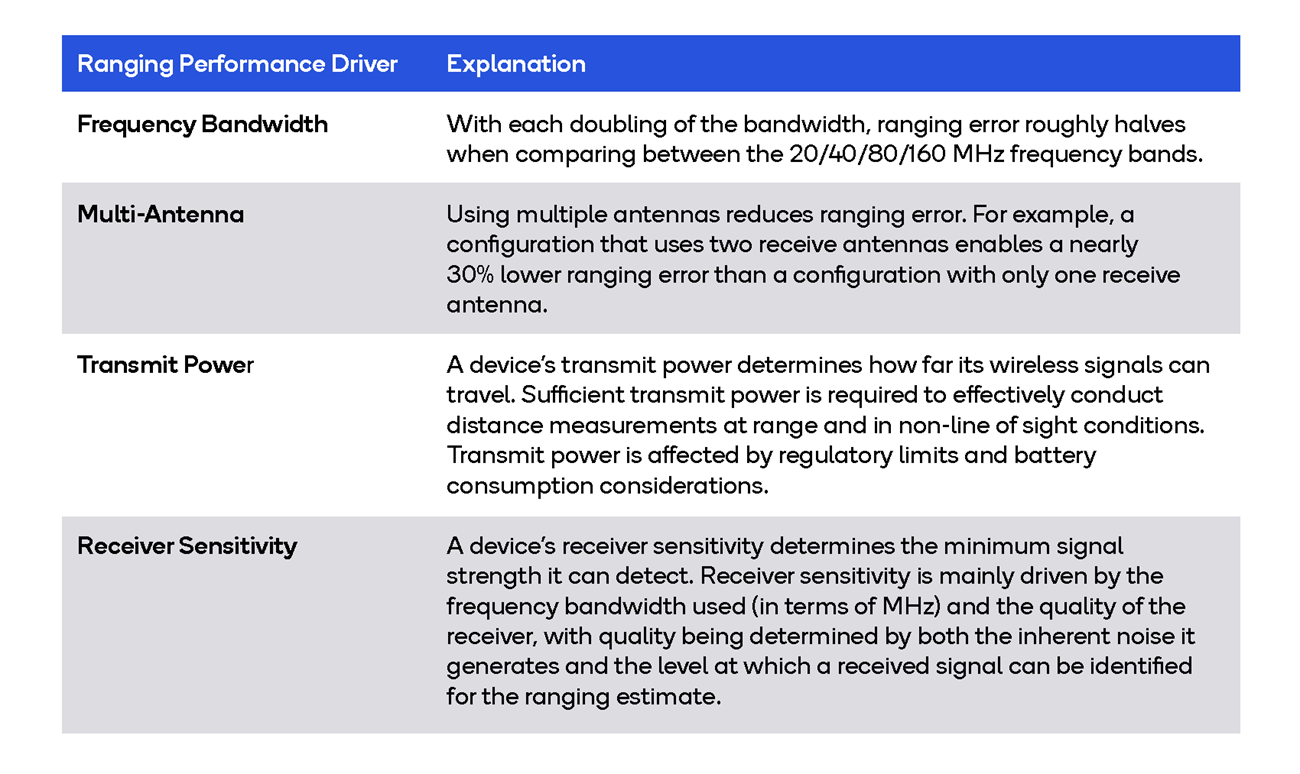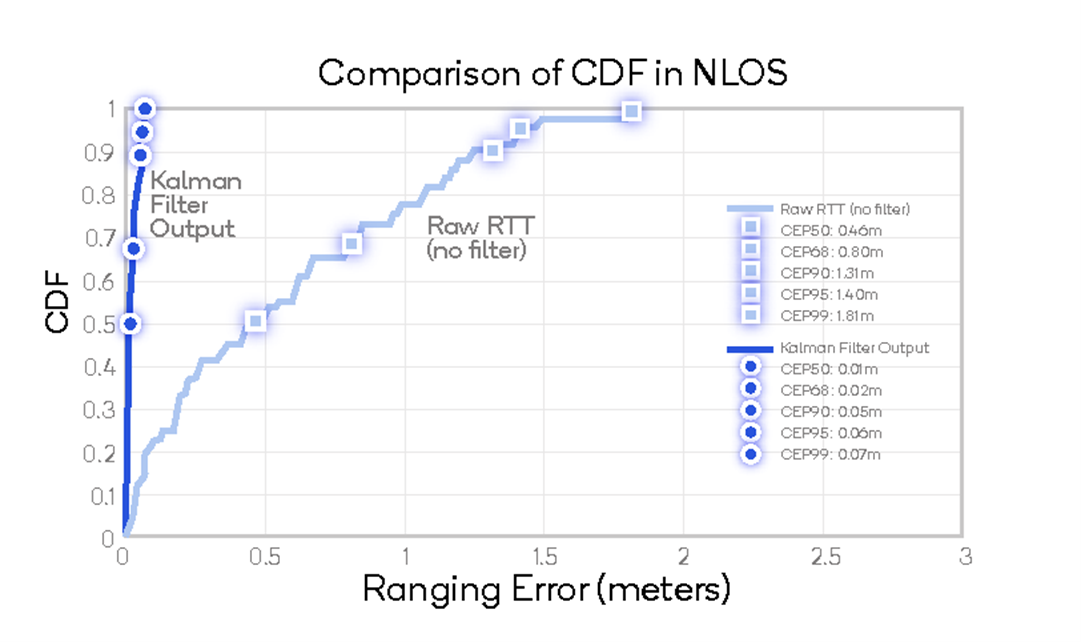Wi-Fi Location™ can enable application developers and other solutions implementers to provide a variety of services for device to device use cases, as well as infrastructure mode use cases involving one or more access points (APs). Examples of services are indoor navigation assistance, asset tracking, geofencing, access control (locking/unlocking), device finding, and device operation (e.g., connecting to the closest monitor).
The Wi-Fi CERTIFIED Location™ interoperability certification program implements the Fine Timing Measurement protocol from IEEE 802.11-2016. A Wi-Fi Alliance® paper outlines the technology and its potential usages.
Qualcomm Technologies has been shipping billions of devices globally with these time-of-flight based Wi-Fi® ranging technologies included, experiencing clear signs of accelerated adoption. Ranging performance – or accuracy of distance measurement – is a key consideration for solutions developers and end users when selecting technologies. What defines Wi-Fi ranging performance and accuracy? Qualcomm Technologies’ latest paper, Qualcomm Wi-Fi Ranging: Delivering ranging and location technologies of tomorrow today, sets out to answer that very question.
Wi-Fi ranging performance
While there are many factors that determine the accuracy of the range/distance estimation made available for use by applications and services, Wi-Fi ranging performance is primarily driven by two vectors:
- The quality and performance of the Wi-Fi radio technology used (Table 1)
- The application of statistical approaches to enhance ranging accuracy, such as averaging and location tracking algorithms
Radio technology performance
When it comes to radio technology performance, there are four key characteristics of a Wi-Fi radio that must be taken into consideration to maximize the accuracy of its measurements: the frequency bandwidth utilization, the use of multi-antenna technology, the transmit power, and receiver sensitivity.

Table 1. High-level overview of the drivers of distance measurement performance of a wireless radio
Enhancing ranging accuracy using statistical approaches
In the case of smartphones or other mobile devices, the Wi-Fi radio passes its ranging measurements on to the mobile device’s operating system (e.g., Android), which in turn makes these measurements available to the application environment for application developers to use in their ranging-based solutions. To increase the accuracy of these range estimations, application developers use statistical approaches such as averaging across multiple measurements and location tracking algorithms.
Averaging
As the name implies, averaging involves taking multiple measurements of a certain distance and calculating their average. This approach is more reliable than using only one measurement and offers a lower error rate. Qualcomm Technologies illustrated the impact of applying averaging by using the measurements collected from a Qualcomm Technologies reference design implementation (using 80 MHz bandwidth). By averaging over 32 bursts collected in less than one second, the 90th percentile accuracy improved from 70 cm to 21 cm.*
Location tracking algorithms
Location tracking algorithms such as Kalman filtering are another way to enhance the range estimates accuracy significantly. To demonstrate this increased accuracy, Kalman filtering algorithms were applied to the data collected by Qualcomm Technologies in an Automotive Digital Key use case setting whereby the user (and their smartphone) moves towards a vehicle in a linear fashion. The Kalman filter predicts and corrects the estimate of the phone’s trajectory to improve ranging accuracy. In less than 0.5 seconds the ranging errors fell well below 10 cm (5 cm for the 90th percentile, 7 cm for the 99th percentile).
The following plot is the Cumulative Distribution Function (CDF), which shows that for the 90th percentile case the initial, unaveraged results have an accuracy of 131 cm whereas the output of the Kalman filter has an accuracy of 5cm.
Figure 1. Cumulative Distribution Function comparing ‘raw’ accuracy results with the outputs of a Kalman filter
In addition to the linear movement scenario, Kalman filtering was applied to a scenario in which the phone moves in a circular movement around a vehicle and one in which the phone is stationary. All cases assume no prior knowledge of movement. Table 2 lists the ranging error levels achieved with Kalman filtering in all three scenarios.
Table 2. Achievable ranging accuracies when using Kalman filtering for different movement scenarios in an automotive setting.
This accuracy has even more potential for improvement when application developers and other solutions implementers can factor in additional information such as prior behaviors or information from other sensors in the device (for example, compass, accelerometer).
Conclusion
The strength of the value proposition of Wi-Fi for device-to-device ranging is driven by the large installed base in mobile phones, accuracies up to 10 cm of precision, and the fact that the Wi-Fi ranging capabilities are inherent in Wi-Fi radios already in devices for data networking purposes. When analyzing the capabilities of Qualcomm® Wi-Fi ranging technology in the context of its actual use in applications and devices across two test scenarios—indoor line of sight and automotive (mostly non-line of sight)—the following conclusion can be made:
By averaging across multiple bursts of ranging measurements, decimeter-level accuracies can be achievable in a real-world environment. For example, in the line of sight testing at the Wi-Fi Alliance lab, at the 90th percentile a 21 cm accuracy* was achieved when averaging over 32 bursts (which lasts less than one second overall).
However, the most significant tools at the disposal of application developers and other solutions implementers are the use of location tracking algorithms. Our analysis shows that with application of the Kalman filter location tracking algorithm, accuracies of less than 10 cm can be achieved, both at the 90th percentile and 99th percentile.
These performance levels can be achieved with Qualcomm Technologies’ products shipping today. In the near term, additional standards-based capabilities will be added, further increasing accuracy, security, scalability, and support for an extended set of use cases.
*A 21 cm accuracy level at the 90th percentile means that in 90 percent of the cases, the accuracy of the measurements is less than 21 cm, and in 10 percent of the cases it is more than 21 cm.
Qualcomm Wi-Fi is a product of Qualcomm Technologies, Inc., and/or its subsidiaries.
The statements and opinions by each Wi-Fi Alliance member and those providing comments are theirs alone, and do not reflect the opinions or views of Wi-Fi Alliance or any other member. Wi-Fi Alliance is not responsible for the accuracy of any of the information provided by any member in posting to or commenting on this blog. Concerns should be directed to info@wi-fi.org.






Add new comment